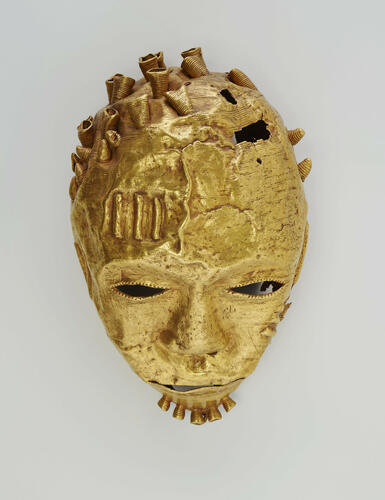-
1 of 253523 objects
Trophy head nineteenth century
Gold | 20.7 x 12.5 x 9.7 cm (whole object) | RCIN 62901
-
An Asante gold trophy head in the form of a hollow mask, with hammered facial features and pierced eyes, nostrils and mouth. Narrow strips of gold on the forehead and cheeks emulate scarification. Wirework coils, some missing, form hair curls and a beard at the base of the chin. There is a hanging hoop beneath the chin.
Masks of this kind represented defeated enemies and were attached by a hoop to ceremonial swords in the state regalia. This may explain the sustained damage to the proper left of the head, which would repeatedly have come into contact with the sword when carried. Heads of this type were made using the lost-wax technique, for which the Asante were renowned. The desired object was modelled in wax and then encased in clay; when dry, the clay was heated until the wax melted within melted and ran off, usually through a hole at the base. The resulting cavity was filled with molten metal and once cool, the clay exterior broken off. Producing such thin and finely worked masks such as this demanded the careful labour of the most sophisticated craftsmen.Provenance
This trophy head belonged to King Kofi Karikari of Asante (c.1837-1884) and was taken from him at Kumasi. It is almost certainly one of the 'seven gold masks, each weighing several ounces' seized by British troops from the palace of the defeated Asantehene during the Anglo-Asante War of 1873-74 (Henry Stanley, Coomassie and Magdala (1876), p.233). Numerous gold items and textiles were removed by Sir Garnet Wolseley's forces, while other gold pieces were paid to the British as settlement of the government's indemnity claim. Some of these objects were sold at a public auction in Cape Coast prior to the troops' return to England; others were bought by Garrard & Co. in London for £11,000 and sold by them in the spring of 1874. The Graphic's account of the sale includes an illustration of this head, described as a 'Mask of Solid Gold'. At that time 'what use they are put to is unknown, they are too small for a man to wear, and besides, are neither pierced for seeing nor breathing' (The Graphic, 11 April 1874, p.335 and 344).
On 2 April 1874 the queen recorded in her Journal that she 'looked at some gold ornaments, huge gold masks, rings, bracelets & other ornaments brought from Coomassie [Kumasi], (all of pure gold), by officers & others, sent in as an indemnity. They are being sold for the benefit of the Army & I have bought some.' The head may been purchased before its appearance at the Garrard & Co. sale, or perhaps acquired afterwards.
First recorded in the North Corridor Inventory, begun in 1866, at Windsor Castle with the note 'Taken from Coffee King of Ashantee at Coomassie' (no. 1203). Lent by Queen Victoria for display at the Royal Military Exhibition in Chelsea, London, 1890 (cat. no.1202). -
Creator(s)
(nationality)Acquirer(s)
